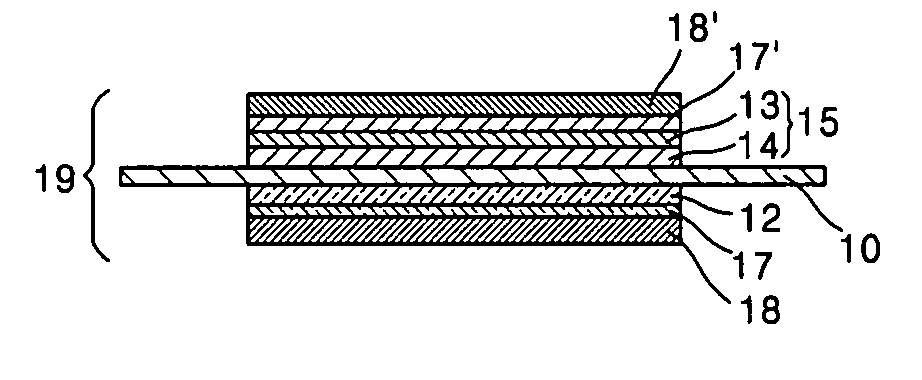Catalyst coated membrane, membrane electrode assembly containing the same, method of producing the same, and fuel cell including the membrane electrode assembly
a technology of membrane electrodes and catalysts, which is applied in the direction of electrochemical generators, cell components, coatings, etc., can solve the problems of insufficient utilization of the effect of increasing the loading concentration when using fuel cells with such supported catalysts, and the difficulty of producing electrodes containing an increased amount of supported catalysts, etc., to achieve maximum catalyst activity and enhance the performance of a unit cell
- Summary
- Abstract
- Description
- Claims
- Application Information
AI Technical Summary
Benefits of technology
Problems solved by technology
Method used
Image
Examples
example 1
[0082]0.89 g of hexachloroplatinic acid (H2PtCl6.xH2O) and 0.40 g of ruthenium chloride (RuCl3.xH2O), which are catalytic metal precursors, were respectively dissolved in 2.5 ml of acetone and mixed to obtain a corresponding catalytic metal precursor mixture, and then 1 g of mesoporous carbon as a carbon support was impregnated with the catalytic metal precursor mixture in a plastic bag. The impregnated carbon support was placed in an electric furnace and subjected to a gas phase reduction reaction under a hydrogen gas stream to prepare a supported catalyst loaded with 35% by weight of PtRu (primary supported catalyst).
[0083]0.769 g of the first supported catalyst was added to 400 g of ethylene glycol to prepare a first supported catalyst mixture. Then, 1.516 g of hexachloroplatinic acid (H2PtCl6.xH2O) and 0.740 g of ruthenium chloride (RuCl3.xH2O), these amounts being 70% by weight of the final loading amount of catalytic metal, were dissolved in 200 g of triple-distilled water, an...
example 2
[0086]1.08 g of hexachloroplatinic acid (H2PtCl6.xH2O), which is a catalytic metal precursor, was dissolved in 6 ml of acetone to obtain a corresponding catalytic metal precursor mixture. Then, 1 g of mesoporous carbon as a carbon support was impregnated with the catalytic metal precursor mixture in a plastic bag. The impregnated carbon support was placed in an electric furnace and subjected to a gas phase reduction reaction under a hydrogen gas stream to prepare a supported catalyst loaded with 30% by weight of Pt (primary supported catalyst).
[0087]1.43 g of the primary supported catalyst was added to 260 g of ethylene glycol to prepare a primary supported catalyst mixture. Then, 2.692 g of hexachloroplatinic acid (H2PtCl6.xH2O), this amount being 60% by weight of the final loading amount of catalytic metal, was dissolved in 300 g of triple-distilled water, and the resulting solution was added to the first supported catalyst mixture. The pH of the resulting mixture was adjusted to ...
example 3
[0096]1.5 g of the 70 wt % PtRu / MC supported catalyst obtained in Example 1 was mixed with 2 g of deionized water, 1 g of ethylene glycol and 2.25 g of a 20 wt % NAFION® ionomer solution to prepare a slurry for forming a catalyst layer.
[0097]The slurry for forming a catalyst layer was bar coated onto a polyethylene film to a thickness of about 30 μm, and then the coating was dried in a vacuum oven at 80° C. to form a 70 wt % PtRu / MC supported catalyst layer.
[0098]Subsequently, a PtRu black non-supported catalyst layer was formed on top of the 70 wt % PtRu / MC supported catalyst layer to form an anode catalyst layer. Here, the PtRu black non-supported catalyst layer was formed as described below.
[0099]3 g of PtRu black was mixed with 3 g of deionized water, 2 g of ethylene glycol and 1.875 g of a 20 wt % NAFION® ionomer solution to prepare a slurry for forming a catalyst layer. The slurry for forming a catalyst layer was coated onto the 70 wt % PtRu / MC supported catalyst layer and dri...
PUM
| Property | Measurement | Unit |
|---|---|---|
| temperature | aaaaa | aaaaa |
| thickness | aaaaa | aaaaa |
| thickness | aaaaa | aaaaa |
Abstract
Description
Claims
Application Information
 Login to View More
Login to View More - R&D
- Intellectual Property
- Life Sciences
- Materials
- Tech Scout
- Unparalleled Data Quality
- Higher Quality Content
- 60% Fewer Hallucinations
Browse by: Latest US Patents, China's latest patents, Technical Efficacy Thesaurus, Application Domain, Technology Topic, Popular Technical Reports.
© 2025 PatSnap. All rights reserved.Legal|Privacy policy|Modern Slavery Act Transparency Statement|Sitemap|About US| Contact US: help@patsnap.com



